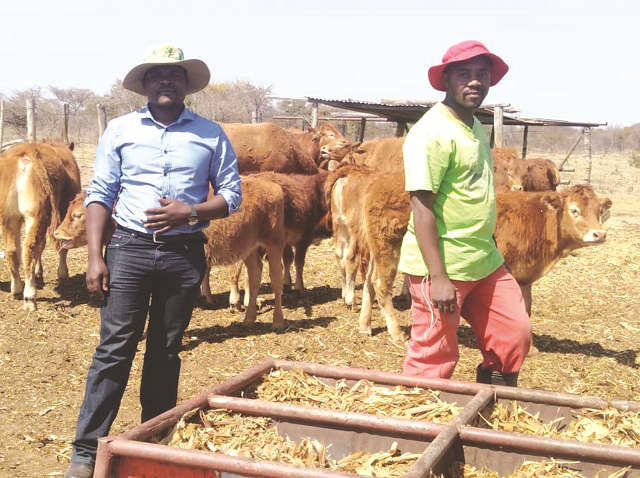
The Sunday News

 Muchero (left) and farm manager Mr Christopher Chirambaguwa inside a cattle pen with Limousin weaners
Muchero (left) and farm manager Mr Christopher Chirambaguwa inside a cattle pen with Limousin weanersDumisani Nsingo, Senior Farming Reporter
LIVESTOCK farmers should invest in breeding cattle with better growth performance, carcass traits and economic benefits to ensure the viability of their enterprises, an official said.
Mr Chalington Tichaona Muchero who is a consultant and project co-ordinator for a Figtree livestock farmer in Matabeleland South Province, Mr Bulukani Scotch Masola said there is a need for farmers to consider rearing beef cattle with traits of high dressing percentage to ensure profitability of their enterprises.
Mr Masola is one of the few Limousin cattle stud breeders in the country, having imported about 150 of the animals from South Africa over a period of two years.
“After we did pen fattening using local breeds we saw that their dressing percentage was around 50 percent but when you are talking of the limousins you are talking of something between 62 to 68 percent meaning that when you slaughter that percentage is meat and we are also talking about meat to bone ratio of 75-82 percent,” said Mr Muchero.
He said the performance of limousins could be equated to that of high yielding crop varities.
“This is a high yielding variety when you are talking of livestock and the emphasis of value addition through Zim Asset we are simply saying can we get an animal that will produce within the given resources in terms of productivity,” said Mr Muchero.
He said the Limousin breed has the ability to easily adapt to the country’s climatic condition and its feed conversion rate surpasses most indigenous breeds.
“The Limousin is an animal which has adapted very well in Zimbabwe through grazing just like any other animal. The amount of feed that it requires is actually less than most of the breeds that we have here in Zimbabwe. The feed conversion ratio of the Limousin is six kgs (kilogrammes) of feed to give you a kg of body weight compared to the indigenous breeds where you are talking of eight to 10kgs to give you a kg of body weight,” said Mr Muchero.
He said the crossing of the Limousin and Brahman breed has the ability to further increase the dressing percentage.
“These animals can be cross-bred with the Brahman breeds to come up with a Brahmousin and when we talk of the Brahman we are talking of dressing percentage of around 53 percent but now a Brahmousin will have dressing percentage of over 60 percent, now we have added value,” said Mr Muchero.
He also urged farmers to consider inseminating their animals with Limousin semen so as to realise better returns.
“The difference between that 50 percent dressing percentage and the 62 to 68 percent of the Limousin that’s the difference between a profit and a loss — that’s the difference between production and productivity. So we are basically saying with the Limousin if done properly definitely one will make a profit and we see it changing the meat industry,” said Mr Muchero.
He said the country’s cattle quality has over the years been affected by inbreeding and poor management.
“There has been a lot of inbreeding that has happened, meaning that we are having small and smaller animals. These animals are prone to diseases and at the same time people should now understand agriculture as a business and people must now make money out of agriculture.
“This idea of having animals that are just lying idle or probably small animals is a thing of the past. Most of the farmers that we have who are doing cattle production especially in the communal areas, you find that person will have 40 animals and half of them are male and if you look at the age those male animals are way above four years,” said Mr Muchero.
He said communal farmers should keep a substantial number of cattle for draught power and milk and adopt the concept of pen fattening so as to sell their animals at reasonable prices.
The Limousin breeder would be auctioning part of his animals at Matobo CC Sales cattle pens on 27 August.
“Basically we cannot necessarily advise all farmers to go and import these animals from South Africa but they can come and buy breeding stock because we will be having some of the pedigree head that we have being sold at Matobo CC Sales pens. So farmers can come in and buy breeding stock,” said Mr Muchero.
@DNsingo



